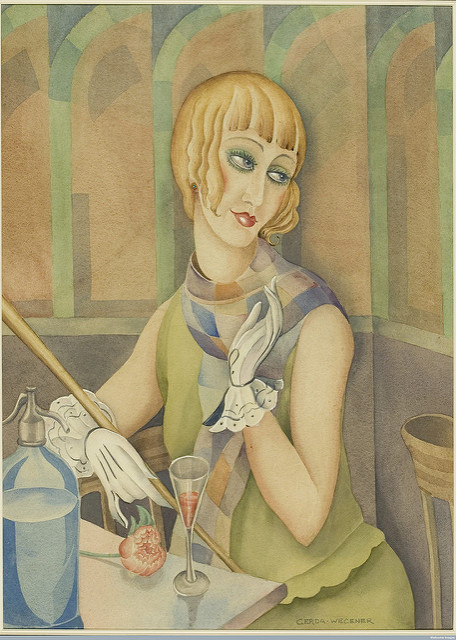The Danish Girl, the Tom Hooper-directed and Academy Award-winning drama about Lili Elbe, one of the first persons to ever undergo a sex reassignment surgery, tells a truly European story, one of love and drama spanning an entire continent, a continent under great change. It is also a story that tragically has many similarities to present-day Europe and transgender Europeans.
Lili Elbe, the real “Danish Girl”
Lili Elbe (whose legal name was Lili Ilse Elvenes) was born in 1882 in the rural Jutland region of Denmark as Einar. In his 20’s, Einar made a name for himself as a skilful artist, painting colourful land- and cityscapes and got the opportunity to study at the Royal Danish Academy of Fine Arts. It was there that Einar met his future wife, Gerda Wegener. Einar and Gerda moved from provincial Copenhagen to the bohemian metropolis of Paris in 1912.
But Lili had debuted to the world long before the couple moved to Paris. After a model did not show up for a session with Gerda, she asked Einar to don women’s clothing and a wig, something he discovered fell very naturally to him. Thus began a journey into a dual life, a life where Einar became Lili, and Lili became Einar. Two different sides of the same coin. In the coming years, Einar was often depressed, while Lili was bright and happy, and in the end, Gerda ended up preferring the jovial Lili to her companion.
In 1930 Einar/Lili found out about an experimental surgery to change his gender and underwent two successful reassignment surgeries, but fell ill after a third one, in which the doctor transplanted a uterus into Lili, presumably in her pursuit to become a mother. Lili Elbe died three months later, 48 years old.

A short history of transgenderism in Europe
Both Lili and Gerda’s stories span an entire era, and an entire continent. Paris was at the centre of European culture in the early 20th century, and artists came all over the world to experience the city of light. When Lili and Gerda first arrived in Paris, they lived in the same hotel room where Oscar Wilde died twelve years earlier. It was here that legendary artists such as Picasso, Hemingway and Fitzgerald met and inspired each other.
It was also the city in which Lili could flower. Gerda often introduced her as Einar’s sister, and Lili radiated femininity at balls and receptions among the multicultural Parisian avant-garde. Furthermore, Lili was not the first person to get a sex reassignment surgery. The German physician and sexologist Magnus Hirschfeld introduced the term “transsexual” in 1920 and was an ardent supporter of sexual minorities. He also founded the Institute for Sexual Science in the liberal-minded inter-war Weimar Republic of Germany. Austrian Sigmund Freud presented the idea of “innate bisexuality”, that all humans are born bisexual, also in 1920.
But the happiness and tolerance of the roaring twenties did not last. In 1930 the Great Depression swept over the world. This was also at the time that Lili and Gerda’s marriage fell apart. Lili began an affair with French art dealer Claude Lejeune, and by the time of Lili’s death Gerda would marry an Italian officer and diplomat, another marriage that ended in a divorce. Gerda died in Denmark nine years later, as Nazi Germany was invading the country, penniless and alcoholised.

The 1930s also brought the rise of Nazism and Fascism, and the persecution of LGBT people. Magnus Hirschfeld’s Institute for Sexual Science was raided and destroyed by Nazis in 1933, and Hirschfeld himself died in exile two years later. In the years following 1933 up to 1945, around 100,000 men all over Europe were arrested as homosexuals; many of them were sent to concentration camps. One of the most famous transgender individuals, Dörchen Richter, who underwent sex reassignment surgery around the same time as Lili, fell victim to this persecution.
Europe and transgenderism today
Today, while sex reassignment surgery is accepted in many countries across Europe, several issues still remain. Lili Elbe wanted a uterus and underwent a very dangerous surgery because she wished to some day become a mother. This very human drive to be a parent is still denied to many transgender people. To this day, 23 European states require transgender people to undergo forced sterilizations before they are allowed to undergo sex reassignment surgeries. And just as Lili/Einar suffered from bouts of depression, transgender people are today one part of the population most at risk to suffer from psychological problems such as depression.
Self-determination and self-identification, so central in many other walks of life, bare little weight in the courts of law when it comes to transgenderism
While the physical and medical boundaries of transgenderism might have been torn down and procedures have become if not commonplace at least secure, the bureaucracy process of transitioning to another gender is not. Apart from the above-mentioned forced sterilizations, all European countries except Denmark require a medical expert statement to be allowed to undergo transitioning. Self-determination and self-identification, so central in many other walks of life, bare little weight in the courts of law when it comes to transgenderism. Introducing a third gender within bureaucracy has been hailed as a huge step forward to accept transgender persons, among many other intersex persons, within the state bureaucracy. However, Malta is the only European country that has introduced such a measure, proving that Europe still has long ways to go before transgender persons might have a passport that shows who they truly are.
Teaser photo: Ted Eytan (Flickr); Licence: CC BY-SA 2.0










